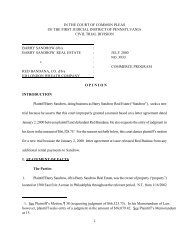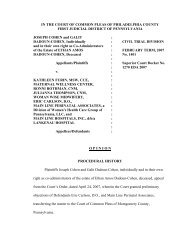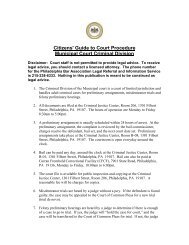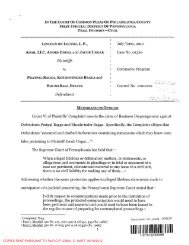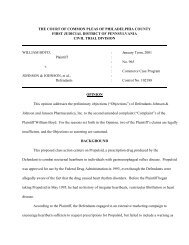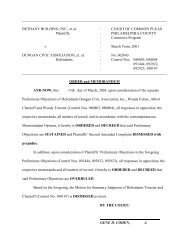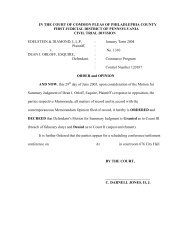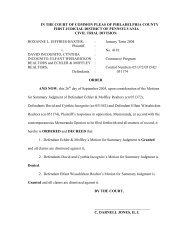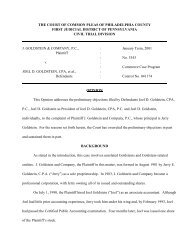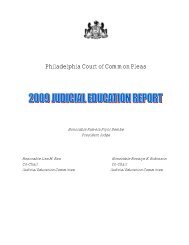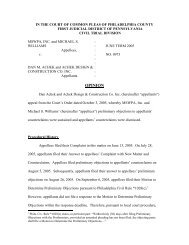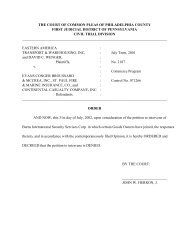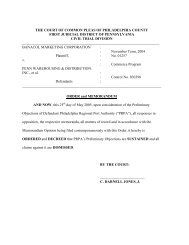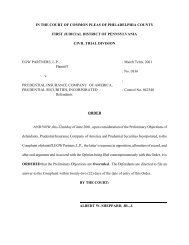BRIAN MALEWICZ, ET. AL. vs MICH'L BAKER - The Philadelphia ...
BRIAN MALEWICZ, ET. AL. vs MICH'L BAKER - The Philadelphia ...
BRIAN MALEWICZ, ET. AL. vs MICH'L BAKER - The Philadelphia ...
Create successful ePaper yourself
Turn your PDF publications into a flip-book with our unique Google optimized e-Paper software.
IN THE COURT COMMON PLEAS OF PHILADELPHIA COUNTY<br />
FIRST JUDICI<strong>AL</strong> DISTRICT OF PENNSYLVANIA<br />
CIVIL TRI<strong>AL</strong> DIVISION<br />
<strong>BRIAN</strong> <strong>M<strong>AL</strong>EWICZ</strong>, <strong>ET</strong>. <strong>AL</strong>., : December 2002<br />
Plaintiffs, :<br />
v. : No. 01741<br />
MICHAEL <strong>BAKER</strong> CORPORATION, <strong>ET</strong>. :<br />
<strong>AL</strong>., : COMMERCE PROGRAM<br />
Defendants. :<br />
: Control Numbers 061853/061848<br />
ORDER<br />
AND NOW, this 15 th day of February, 2005, upon consideration of the Motion<br />
for Summary Judgment of Defendants Fred Johnson and Dwight Sangrey (cn 061853)<br />
and the Motion for Summary Judgment of Defendants Michael Baker Corporation and<br />
Donald P. Fusulli, Jr. (cn 061848), all responses in opposition, Memoranda, all matters of<br />
record and in accord with the contemporaneous memorandum opinion being filed of<br />
record, it hereby is ORDERED and DECREED that Defendants’ respective Motions for<br />
Summary Judgment are Granted and plaintiffs’amended complaint is dismissed against<br />
all Defendants.<br />
BY THE COURT,<br />
_____________________________<br />
C. DARNELL JONES, II, J.
IN THE COURT COMMON PLEAS OF PHILADELPHIA COUNTY<br />
FIRST JUDICI<strong>AL</strong> DISTRICT OF PENNSYLVANIA<br />
CIVIL TRI<strong>AL</strong> DIVISION<br />
<strong>BRIAN</strong> <strong>M<strong>AL</strong>EWICZ</strong>, <strong>ET</strong>. <strong>AL</strong>., : December 2002<br />
Plaintiffs, :<br />
v. : No. 01741<br />
MICHAEL <strong>BAKER</strong> CORPORATION, <strong>ET</strong>. :<br />
<strong>AL</strong>., : COMMERCE PROGRAM<br />
Defendants. :<br />
: Control Numbers 061853/061848<br />
JONES, II, J.<br />
MEMORANDUM OPINION<br />
Presently before the court is the Motion for Summary Judgment of Defendants<br />
Fred Johnson and Dwight Sangrey and the Motion for Summary Judgment of Defendants<br />
Michael Baker Corporation and Donald P. Fusilli, Jr. For the reasons that follow,<br />
Defendants respective Motions for Summary Judgment are Granted.<br />
I. Parties<br />
BACKGROUND<br />
<strong>The</strong> parties involved in this suit are the following: the plaintiffs are Brian T.<br />
Malewicz, Michael D. Burns, David L. Jannetta, Mark J. DeNino and Mobility<br />
Technologies Inc. (Mobility). Mobility is in the business of designing and installing real-<br />
time automobile traffic sensor networks in major metropolitan areas throughout the<br />
United States. Mobility was formerly known as Argus Network, Inc. Jannetta is a<br />
principal and shareholder of Mobility. DeNino, Burns and Malewicz are shareholders of<br />
Mobility but are not employed by the company.<br />
<strong>The</strong> defendants in this action are Michael Baker Corporation (“MBC”), Donald P.<br />
Fusilli (“Fusilli”), Fred Johnson, Dwight Sangrey and Howard Kraye. MBC is an
engineering firm. Since September 1999, Fusilli has been a member of MBC’s senior<br />
management team and has been the company’s president since April 2000. In April<br />
2001, Fusilli gained the additional title of chief executive officer.<br />
Defendants Kraye, Sangrey and Johnson are or were principals and shareholders of<br />
Santa Fe Technologies (“SFT”). SFT is a New Mexico company engaged in the business<br />
of installing and maintaining sensors for various purposes such as recording<br />
environmental data or recording automobile traffic density. Sangrey was SFT’s CEO<br />
from 1996 through the latter part of 1999. Additionally, Kraye, Sangrey and Johnson<br />
have been the directors of the company throughout the relevant time period.<br />
II. Factual Background<br />
A. SFT and MBC’s Exclusivity Agreement and Due Diligence Period<br />
(January 1997 to May 1997).<br />
In January 1997, MBC and SFT entered into an Exclusivity Agreement whereby<br />
MBC loaned SFT $600,000.00 for a period of ninety days to conduct due diligence and<br />
enter into an Acquisition Agreement with SFT. According to the terms of the agreement,<br />
upon expiration of the ninety day period without an Acquisition Agreement, or upon<br />
default by SFT or notice by MBC that it will not proceed with acquisition, SFT would<br />
have 120 days to repay the full amount of the loan plus accrued interest. Repayment of<br />
the loan was secured by the pledge of 100 percent of SFT stock and by personal<br />
guarantees issued by Fred Johnson, Howard Kraye and their wives.<br />
In May 1997, after performing due diligence, MBC ultimately decided not to<br />
proceed with the acquisition of SFT. As such, MBC informed SFT that under the terms<br />
of the Exclusivity Agreement it had 120 days from the date of the expiration of the<br />
negotiation period to repay the $600,000.00 plus interest. (Plaintiffs’ Exhibit 10). Over a<br />
2
two year period, SFT paid the debt down to an outstanding principal amount of<br />
$117,405.48 but it was never paid off completely. Although MBC made repeated<br />
demands for payment, it never exercised its legal rights for payment.<br />
B. SFT and Mobility’s Plan of Merger and Termination. (May 1998-<br />
March 5, 1999).<br />
In May or June of 1998, Sangrey (SFT) proposed to Jannetta (Mobility) that<br />
Mobility merge with SFT so that the companies could bid for an upcoming federal<br />
contract to be offered by the Federal Highway Administration for the design and<br />
installation of real-time traffic networks in two major metropolitan areas, <strong>Philadelphia</strong><br />
and Pittsburgh, Pennsylvania.<br />
On November 2, 1998, Mobility entered into an Agreement and Plan of Merger<br />
with SFT. (Plaintiffs’ Exhibit “32”). In the weeks following the signing of the merger<br />
agreement, Mobility advanced SFT $240,000 to help with SFT’s cash-flow problems.<br />
SFT represented that the monies would be used to cover ordinary business expenses such<br />
as payroll.<br />
In December 1998, SFT and Mobility learned that the Federal Highway<br />
Administration issued its invitation to bid on the federal contract and that all contract bids<br />
were due by March 1, 1999. On January 25, 1999, Sangrey (SFT), in preparation for a<br />
meeting with SFT’s Board, prepared a status report stating that the plan merger<br />
agreement with Mobility was on hold pending resolution of several issues. <strong>The</strong> existing<br />
approved merger plan contained a condition required by the SFT Board that a state or<br />
federal contract must be in hand to conclude the merger between SFT and Mobility.<br />
(Plaintiffs’ Exhibit “45”). In the status report, Sangrey discussed the options available to<br />
3
SFT in the event the federal contract was not awarded and the plan merger did not occur.<br />
(Id.). One of the options discussed was a merger with MBC. (Id.).<br />
On February 19, 1999, despite the merger agreement with SFT and unknown to<br />
SFT, Mobility principals David Jannetta and Michael Burns called the principals of a<br />
competing New Mexico firm, Sensor Management Systems (“SMS”), to “discuss<br />
working together” on the federal bid with Mobility instead of SFT. <strong>The</strong> next day, Burns<br />
wrote an email to his supervisor Mark DeNino proposing to swap SMS for SFT in<br />
connection with the federal bid. DeNino approved but expressed concern that SFT might<br />
sue. On February 22, 1999, Burns met with Jerry Musnitsky and Mark Nash of SMS in<br />
San Francisco to discuss the terms of the merger between SMS and Mobility.<br />
On February 24, 1999, Mobility and SMS set forth in writing their agreement and<br />
understanding regarding the terms of the merger of their companies. (Plaintiffs’ Exhibit<br />
48). On the same day the merger agreement between SMS and Mobility was signed,<br />
Jannetta (Mobility) wrote to Sangrey (SFT) to terminate the Agreement and Plan of<br />
Merger with SFT citing Mobility’s lack of desire to proceed with the merger. (Plaintiffs’<br />
Exhibit “49”).<br />
On February 26, 1999, counsel for SFT acknowledged receipt of Mobility’s letter<br />
terminating the merger agreement between Mobility and SFT. (Plaintiffs’ Exhibit “50”).<br />
<strong>The</strong> letter also placed Mobility as well as SMS on notice of potential legal action by SFT<br />
against Mobility for tortious interference with the federal contract bid, unjust enrichment<br />
and other potential causes of action. (Plaintiffs’ Exhibit “50”). 1<br />
On March 1, 1999, Mobility acquired SMS and that same day Mobility submitted<br />
its bid for the federal highway contract without SFT. In connection with the bid, MBC<br />
1 Plaintiffs admit that MBC played no part in the letter by SFT threatening litigation against Mobility.<br />
4
served as a subcontractor. Mobility was ultimately awarded the federal contract by the<br />
Federal Highway Administration to install traffic sensors in Pittsburgh and <strong>Philadelphia</strong>,<br />
Pennsylvania.<br />
In the meantime, unknown to Mobility, MBC contacted SFT questioning whether<br />
MBC should continue to be involved with the bid process. (Plaintiffs’ Exhibit 22 p. 421-<br />
424).<br />
On March 5, 1999, Sangrey (SFT) pursued his contingency plan expressed in his<br />
January 1999 status report to SFT’s Board, he asked MBC to purchase SFT’s assets.<br />
(Plaintiffs’ Exhibit “51”). MBC responded that it was not interested in purchasing SFT’s<br />
assets. (Id.).<br />
In late April or May 1999, MBC contacted SFT to express its concern with the<br />
technical competence of the team, Mobility and SMS, and sought advice from SFT on<br />
how to handle the situation. (Plaintiffs’ Exhibit “22” p. 421-424).<br />
C. Mobility and ICG (1998- July 1999).<br />
Sometime prior to the award of the federal contract and thereafter, Mobility<br />
sought financing from Internet Capital Group (“ICG”). Prior to delivering the requested<br />
financing to Mobility, ICG performed due diligence. As part of the due diligence<br />
process, it is unknown whether the letter dated February 26, 1999 from SFT threatening<br />
suit was provided to ICG. (Defendants’ Exhibit “18” p. 80; Defendants’ Exhibit “8” p.<br />
110; Defendants’ Exhibit “33”). However, Burns recalls discussing the termination of<br />
the merger agreement with SFT and the SMS acquisition with ICG. (Defendants’ Exhibit<br />
“18” p. 80). According to Burns, ICG was aware that SFT was unhappy with the<br />
termination of the merger, that Mobility received advice from counsel and concluded that<br />
5
it had a right to terminate the merger agreement with SFT and that Mobility did not<br />
believe the litigation instituted by SFT was meritorious. (Id. p. 82).<br />
At the time Mobility was discussing its financing plans with ICG, Mobility<br />
disclosed its plans to obtain financing from ICG with MBC and other vendors who were<br />
working along with Mobility on the federal contract in the spring of 1999. (Plaintiffs’<br />
Exhibit “20” p. 31-32; 35). Mobility informed MBC and its other vendors that it hoped<br />
to close the transaction in late July, 1999. (Id. p. 41).<br />
<strong>The</strong> discussions between ICG and Mobility progressed and ultimately ICG<br />
delivered a term sheet to Mobility on July 28, 1999. (Defendants’ Exhibit “34”). <strong>The</strong><br />
term sheet delivered to Mobility outlines the terms and conditions of a proposed<br />
investment by ICG in Mobility and was solely an expression of intentions and was not to<br />
be construed as a binding agreement. (Defendants’ Exhibit “34”). <strong>The</strong> transaction was<br />
expected to close on or before August 15, 1999. (Id.). In addition to a term sheet, a stock<br />
swap was also drafted between ICG, Burns and Malewicz. (Id. p. 187-188).<br />
D. <strong>The</strong> New Mexico Lawsuit (7-28-99).<br />
On the day that ICG delivered the term sheet to Mobility, SFT filed a lawsuit<br />
against Mobility, DeNino, Burns, Jannetta and three principals of SMS, Nash, Musnitsky<br />
and Dollar in New Mexico. <strong>The</strong> gravamen of SFT’s claims were (1) Mobility and its<br />
principals stole SFT’s proprietary information and used that information to win the<br />
federal contract, (2) Nash, Musnitsky and Dollar—all of whom were minority<br />
shareholders, former employees, and competitors of SFT—misappropriated a corporate<br />
opportunity belonging to SFT, and otherwise breached fiduciary and unspecified “other”<br />
duties purportedly owed by those defendants to SFT and (3) civil conspiracy among all of<br />
6
the defendants for their alleged tortious behavior. On August 3, 1999, discovery requests<br />
and the complaint were transmitted by overnight delivery to the named defendants.<br />
On or about August 4, 1999, Mobility and its officers and directors were in receipt<br />
of the lawsuit filed by SFT. At the time the lawsuit was received, Mobility’s transaction<br />
with ICG had not closed. Upon receipt of the lawsuit, plaintiffs allege that ICG<br />
immediately informed Mobility that the terms of the transaction would have to be<br />
changed because of the added risk to ICG created by the filing of the New Mexico<br />
litigation. (Plaintiffs’ Exhibit “54”). ICG’s investment in Mobility ultimately closed in<br />
October 1999.<br />
E. Requests to Purchase MBC’s Note to SFT.<br />
On September 8, 2000, counsel for MBC received a communication from counsel<br />
representing David Broeker Industries, LLC who expressed an interest in purchasing<br />
MBC’s interest in the outstanding promissory note due from SFT and the security<br />
pledged therein. (Plaintiffs’ Exhibit “61”). As a result, on October 11, 2000, a<br />
confidentiality agreement was forwarded to MBC for review and signature. (Plaintiffs’<br />
Exhibit “62”).<br />
On December 4, 2000, MBC sent a formal demand letter to SFT demanding<br />
repayment and stating that legal action is certain to result if the loan was not repaid.<br />
(Plaintiffs’ Exhibit “63”). SFT responded by stating that it had no funds to repay the<br />
balance but had several plans in the works such as a commercial prospect involving a<br />
portable traffic monitoring tower developed by them which uses microwave and acoustic<br />
technology which does not require road sensors and SFT’s New Mexico lawsuit which<br />
Kraye stated was in its final stages. (Plaintiffs’ Exhibit “64”). MBC never heard from<br />
7
David Broeker Industries nor did they contact them on their pursuit of purchasing SFT<br />
indebtedness.<br />
In April 2001, Jannetta (Mobility) contacted MBC’s chief executive officer,<br />
Fusilli and expressed an interest in purchasing SFT’s debt. Fusilli replied that he would<br />
check into the matter more and get back to Jannetta. In August 2001, Jannetta again<br />
contacted Fusilli about purchasing the indebtedness; Fusilli referred Jannetta to MBC’s<br />
general counsel. On August 21, 2001, Jannetta and MBC’s counsel discussed the status<br />
of the SFT debt and collateral. (Plaintiffs’ Exhibit “68”). Jannetta offered to pay MBC<br />
10 or 20 cents on the dollar and asked MBC to make a counter offer. Fusilli informed<br />
Jannetta that the offer was under consideration.<br />
On September 7, 2001, MBC’s general counsel contacted Kraye and questioned<br />
him as to when payment would be received on the note. (Plaintiffs’ Exhibit “70”). Kraye<br />
indicated that SFT had no money to repay the debt. (Id.) MBC’s general counsel<br />
informed Kraye that MBC had been approached by a firm interested in acquiring its<br />
position on the note and foreclosing on the stock of SFT. (Id.). According to MBC<br />
counsel, Kraye surmised that the firm was Mobility. (Id.). <strong>The</strong>reafter, MBC counsel<br />
informed Mobility that it had no desire to engage in a transaction that may result in MBC<br />
becoming involved in the litigation against Mobility. (Id.)<br />
On October 1, 2001, counsel for MBC received a phone call from Johnson (SFT).<br />
(Plaintiffs’ Exhibit 80). Johnson informed MBC counsel that SFT’s only asset was the<br />
lawsuit against Mobility. (Id ). Johnson further stated that he is judgment proof and that<br />
he wanted to see MBC get its money back and stated that he may have a potential buyer<br />
of the MBC note. (Id.).<br />
8
<strong>The</strong>reafter, in or about the end of 2001 and beginning of 2002, Malewicz<br />
discovered from Mark Nash, a co defendant in the New Mexico litigation, that Kraye<br />
informed him that the SFT lawsuit was a devised plan to extort money from Mobility.<br />
(Plaintiffs’ Exhibit “21” p. 160-161).<br />
In December 2002, plaintiffs commenced this action against defendants alleging<br />
claims of tortious interference with prospective contractual relations (Count I), prima<br />
facie tort under New Mexico law (Count II), malicious abuse of process (Count III) and<br />
civil conspiracy to interfere with prospective contractual relations (Count IV), civil<br />
conspiracy to commit prima facie tort (Count V), and civil conspiracy to commit<br />
malicious abuse of process (Count VI). Defendants MBC and Donald P. Fusilli, Jr. filed<br />
preliminary objections to plaintiffs’ complaint. On August 6, 2003, the court entered an<br />
order dismissing the claims for malicious abuse of process and civil conspiracy to<br />
commit malicious abuse of process. <strong>The</strong> court also sustained objections for plaintiffs<br />
failure to attach a document and as to the specificity of the allegations and required<br />
plaintiffs to file an amended complaint. Defendants have now filed the instant motions<br />
for summary judgment.<br />
I. LEG<strong>AL</strong> STANDARD<br />
DISCUSSION<br />
A proper grant of summary judgment depends upon an evidentiary record that<br />
either (1) shows the material facts are undisputed or (2) contains insufficient evidence of<br />
facts to make out a prima facie cause of action or defense. Destefano & Associates, Inc.<br />
v. Cohen, 2002 WL 1472340,* 2 (Pa. Com. Pl. 2002) (Herron, J.). Under Pa. R.C. P.<br />
1035.2(2), a defendant may make the showing necessary to support the entry of summary<br />
9
judgment by pointing to evidence which indicates that the plaintiff is unable to satisfy an<br />
element of his cause of action. Id. In response, the nonmoving party must adduce<br />
sufficient evidence on an issue essential to its case and on which it bears the burden of<br />
proof such that a jury could return a verdict favorable to the non-moving party. Id.<br />
Summary judgment may only be granted in cases where it is clear and free from doubt<br />
that the moving party is entitled to judgment as a matter of law.<br />
II. Plaintiffs’ Claims Against Defendants Are Barred by the Applicable Statute of<br />
Limitations.<br />
Moving defendants argue that the statute of limitations bars all claims made<br />
against them since the plaintiffs knew of their injury as early as July 28, 1999 when SFT<br />
filed the lawsuit in New Mexico against Mobility, its officers and other related<br />
companies. Plaintiffs on the other hand argue that the discovery rule tolls the running of<br />
the statute of limitations. For the reasons discussed below, this court finds that the statute<br />
of limitations bars all of plaintiffs’ claims against defendants.<br />
Pennsylvania’s two year statute of limitations applies to the case at hand. See 42<br />
Pa. C. S. A. § 5524. 2 <strong>The</strong> statute of limitations begins to run as soon as the right to<br />
institute and maintain a suit arises; lack of knowledge, mistake or misunderstanding does<br />
not toll the statute of limitations. Pocono International Raceway Inc. v. Pocono Produce<br />
Inc., 503 Pa. 80, 84, 468 A.2d 468, 471 (1983). A person asserting a claim is under a<br />
duty to use all reasonable diligence to be properly informed of the facts and<br />
circumstances upon which a potential right of recovery is based and to institute suit<br />
2 <strong>The</strong> following actions and proceedings must be commenced within two years pursuant to 42 Pa. C.S.A. §<br />
5524, assault, battery, false imprisonment, false arrest, malicious prosecution or malicious abuse of process.<br />
Additionally, any other action or proceeding to recover damages for injury to person or property which is<br />
founded on negligent, intentional or otherwise tortious conduct or any other action or proceeding sounding<br />
in trespass, including deceit or fraud.<br />
10
within the prescribed statutory period. C.J.M. v. Archdiocese of Phila., 67 Pa. D. & C.<br />
4 th 474, 481 (2004).<br />
A judicially created exception, known as the discovery rule, exists to toll the<br />
statute of limitations. <strong>The</strong> discovery rule tolls the statute of limitations until the plaintiff<br />
knows or reasonably should know that (1) he has sustained an injury and (2) his injury<br />
has been caused by another party’s conduct. Weik v. Estate of Brown, 794 A.2d 907,<br />
909 (Pa. Super. 2002). <strong>The</strong> limitations period begins to run when the injured party<br />
“possess[es] sufficient critical facts to put him on notice that a wrong has been committed<br />
and that he need investigate to determine whether he is entitled to redress.” C.J.M. v.<br />
Archdiocese of Phila., supra at 482 (quoting Haggart v. Cho, 703 A.2d 522, 526 (Pa.<br />
Super. 1997). In determining whether to apply the discovery rule to a case, “the court<br />
must address the ability of the injured party, exercising reasonable diligence, to know that<br />
the party has been injured by the act of another.” Bowe v. Allied Signal Inc., 806 A.2d<br />
435, 439 (Pa. Super. 2002).<br />
<strong>The</strong> party seeking to invoke the discovery rule bears the burden of establishing<br />
the inability to know he or she has been injured by the act of another despite the exercise<br />
of reasonable diligence. Reasonable diligence is defined as “a reasonable effort to<br />
discover the cause of an injury the facts and circumstances present in the case.”<br />
Matthews v. Roman Catholic Diocese of Pittsburgh, 67 Pa. D. & C. 4 th 393, 396 (2004)<br />
(citing Cochran v. GAF Corp., 542 Pa. 210, 217, 666 A.2d 245, 249 (1995)).<br />
Since the discovery rule’s application involves a factual determination as to<br />
whether the plaintiff exercised reasonable diligence in discovering the cause of the injury,<br />
ordinarily a jury must decide whether the discovery rule applies. Id. However, whenever<br />
11
easonable minds would not differ in finding that the plaintiff has failed to exercise<br />
reasonable diligence, the court shall decide the matter rather then submit it to a jury. Id<br />
(citing Weik v. Estate of Brown, supra. 794 A.2d at 909)).<br />
A. Defendants Johnson and Sangrey.<br />
In the amended complaint as well as the response to defendants’ motion for<br />
summary judgment, Plaintiffs allege that the filing of the New Mexico lawsuit by the<br />
SFT defendants thwarted the proposed $19,000,000 infusion of capital which directly<br />
resulted in significant changes to the structure of the financing ultimately obtained by<br />
Mobility causing plaintiffs substantial harm.<br />
<strong>The</strong> SFT defendants filed the New Mexico lawsuit on July 28, 1999. <strong>The</strong> instant<br />
lawsuit was filed on December 12, 2002. Although plaintiffs argue that reasonable minds<br />
could plainly differ as to when plaintiffs should have known (a) that SFT was seeking to<br />
extort a payment of money from Mobility in order to pay off its indebtedness to MBC,<br />
and (b) that MBC shared information with SFT regarding the timing of Mobility’s fund<br />
raising efforts, reasonable minds can not differ as to when plaintiffs suffered an injury.<br />
As set forth in the amended complaint as well as the record evidence before the<br />
court, plaintiffs suffered an injury at the time the New Mexico lawsuit was filed on July<br />
28, 1999. It is that date which begins the running of the statute of limitation. Whether<br />
plaintiffs were aware of the motive behind the filing of the New Mexico lawsuit is not<br />
determinative as to when the statute of limitations begins to run. Rather, it is when<br />
plaintiffs discovered they were injured that begins the clock for statute of limitation<br />
purposes.<br />
12
<strong>The</strong> record evidence demonstrates that (1) Burns, Jannetta and Malewicz knew<br />
that they were injured by the filing of the lawsuit on July 28, 1999, (2) believed that the<br />
timing of the lawsuit to be very suspicious and frivolous and (3) knew that SFT and its<br />
officers and directors caused their injury. <strong>The</strong> evidence presented to the court leads to one<br />
conclusion, the statute of limitations began to run on July 28, 1999 when SFT filed the<br />
lawsuit in New Mexico against Mobility and knew their injury was caused by SFT and its<br />
officers and directors. Once plaintiffs became aware of the injury and who occasioned it,<br />
they were under a duty to investigate the matter and commence a cause of action.<br />
Burton-Lister v. Siegel, Sivitz and Lebed Assocs., 798 A.2d 231, 237 (Pa. Super. 2002).<br />
Plaintiffs, in an attempt to toll the limitations period, argue that the discovery rule<br />
exception should be applied to toll the limitations period. <strong>The</strong> court finds plaintiffs<br />
reliance upon the discovery rule to be misplaced. Under the discovery rule, the<br />
limitations period does not begin to run until it is reasonably possible for a party to<br />
discover that he or she has been injured by the act of another. Here, as demonstrated<br />
above, plaintiffs knew (discovered) they were injured on or about August 4, 1999 when<br />
they received a copy of the New Mexico lawsuit which caused the terms of the ICG<br />
financing to change. As such, the court finds that the discovery rule exception does not<br />
apply since the parties were aware of the injury and the cause of injury within the<br />
limitations period. 3 Based on the foregoing, Sangrey and Johnson’s motion for summary<br />
judgment is granted.<br />
3<br />
Although, a formal motion has not been filed by defendant Howard Kraye, the court finds that plaintiffs’<br />
claims against Kraye are also time barred.<br />
13
B. MBC and Fusilli.<br />
Mobility maintains that it had no knowledge of and no ability to gain knowledge<br />
that MBC shared information regarding the timing of Mobility’s fund raising effort with<br />
SFT. Plaintiffs maintain that it was not until the summer of 2001 that Jannetta first<br />
communicated with Fusilli about Mobility’s interest in purchasing the SFT indebtedness<br />
and it was only after that time that Mobility learned that MBC was acting against its<br />
economic interests by refusing to negotiate with a willing buyer.<br />
Plaintiffs further maintain that it was not until after Jannetta’s contact with Fusilli<br />
that Mobility learned that a co-defendant in the New Mexico litigation and a friend of<br />
Kraye’s, Mark Nash, had been told by Kraye that SFT’s principals intended to<br />
recapitalize the company through monies paid by Mobility in the New Mexico lawsuit.<br />
<strong>The</strong>re are two grounds for invoking the discovery rule. <strong>The</strong> first ground is that<br />
the existence of the injury was not known and could not have been reasonably ascertained<br />
within the limitations period. <strong>The</strong> second ground is that the plaintiff knew of the injury<br />
but exercising reasonable diligence, did not know the injury was caused by the tortious<br />
act of another. See Matthews v. Roman Catholic Diocese of Pittsburgh, 67 Pa. D. & C.<br />
4 th 393, 397 (Pa. Com. Pl. 2004). As it pertains to the MBC defendants, the second<br />
ground is invoked. While plaintiffs knew of the injury within the limitations period, it is<br />
plaintiffs’ position that until late 2001 they neither knew nor had reason to know that they<br />
had been injured by the conduct of the MBC defendants. 4<br />
As stated previously, the discovery rule provides that where the existence of the<br />
injury is not known to the complaining party and such knowledge cannot reasonably be<br />
4 This court has been unable to find any Pennsylvania appellate authority providing any guidance for the<br />
second ground of the discovery rule except for the case law on the discovery rule itself.<br />
14
ascertained within the prescribed statutory period, the limitations period does not begin to<br />
run until the discovery of the injury is reasonably possible. <strong>The</strong> discovery rule applies in<br />
only the most limited of circumstances, where the plaintiff despite, the exercise of<br />
reasonable diligence, was unable to discover his or her injury or its cause. <strong>The</strong> party<br />
seeking to invoke the discovery rule bears the burden of establishing the inability to know<br />
he or she has been injured by the act of another despite the exercise of reasonable<br />
diligence. Cochran v. GAF Corp., 666 A.2d 245, 249 (Pa. 1995).<br />
Applying the foregoing standard to the instant matter, the court finds that<br />
Plaintiffs have failed to demonstrate that they exercised reasonable diligence in<br />
discovering that MBC was the cause of their injury. Once the lawsuit was filed by the<br />
SFT defendants in New Mexico, plaintiffs had a duty to investigate to determine if parties<br />
other than the SFT defendants were involved. Although plaintiffs suffered an injury as a<br />
result of the New Mexico lawsuit, they waited more than two years to determine all those<br />
that were involved in causing the injury. Indeed had the plaintiffs instituted the instant<br />
lawsuit within two year limitations period against the SFT Defendants, the alleged<br />
involvement of the MBC defendants would have been discovered within the limitations<br />
period. No reasonable minds would disagree that Mobility failed to exercise reasonable<br />
diligence in discovering MBC’s involvement.<br />
In C.J. M. v. Archdiocese of <strong>Philadelphia</strong>, 67 Pa. D.&C. 4 th 474 (2004), the court<br />
was faced with a similar situation. In C.J.M., plaintiffs commenced lawsuits against<br />
various religious authorities alleging they suffered abuse during their childhoods.<br />
Defendants filed a motion for judgment on the pleadings alleging that the statute of<br />
limitations barred plaintiffs’ claims against the Archdiocesan defendants. Plaintiffs<br />
15
argued that the discovery rule tolled the statute of limitations in their cases. Similar to<br />
the plaintiffs herein, the plaintiffs in C.J.M. admitted that they were injured and that they<br />
were aware of their injuries at the time they were abused. Nonetheless, the plaintiffs in<br />
C.J.M. argued that they were unaware of the Archdiocesan acts until various disclosures<br />
were made in 2002 through 2004, after the limitations period expired.<br />
<strong>The</strong> court in C.J.M. found that plaintiffs’ claims against the Archdiocese were<br />
time barred and granted defendants motion. <strong>The</strong> court reasoned that while the<br />
Archdiocesan defendants may have contributed to the harm caused by the priests, they<br />
did not create a new injury, a creeping injury or alter the cause of the injury. Id. 484.<br />
<strong>The</strong> court found that while the Archdiocesan’s actions may have contributed to plaintiffs’<br />
initial injuries, the Archdiocesan’s actions were a secondary cause of action related to the<br />
injury brought about by the abuse. Id. As such, the court found that the statute of<br />
limitations must be deemed to begin to run at the time of the abuse itself, not when the<br />
various disclosures were made in 2002 through 2004. Id.<br />
<strong>The</strong> court finds the reasoning applied in C.J.M. to be persuasive. Here, like the<br />
plaintiffs in CJM, plaintiffs ask this court to separate the harm caused by each of the<br />
defendants, SFT and MBC, and create a separate clock for statute of limitation purposes.<br />
However, plaintiffs fail to provide the court with any evidence to suggest that they<br />
suffered a new injury as a result of MBC’s actions. <strong>The</strong> court finds that plaintiffs<br />
suffered an injury on July 28, 1999 by the filing of the lawsuit in New Mexico and that<br />
with the exercise of reasonable diligence plaintiffs could have discovered that the MBC<br />
defendants were involved within the limitations period. Accordingly, the court finds that<br />
plaintiffs’ claims against the MBC defendants are time barred.<br />
16
CONCLUSION<br />
For the foregoing reasons, Defendants respective Motions for Summary Judgment<br />
are Granted and Plaintiff’s amended complaint is dismissed against all Defendants. An<br />
Order contemporaneous with this Opinion will follow.<br />
BY THE COURT,<br />
___________________________<br />
C. DARNELL JONES, II, J.<br />
17



